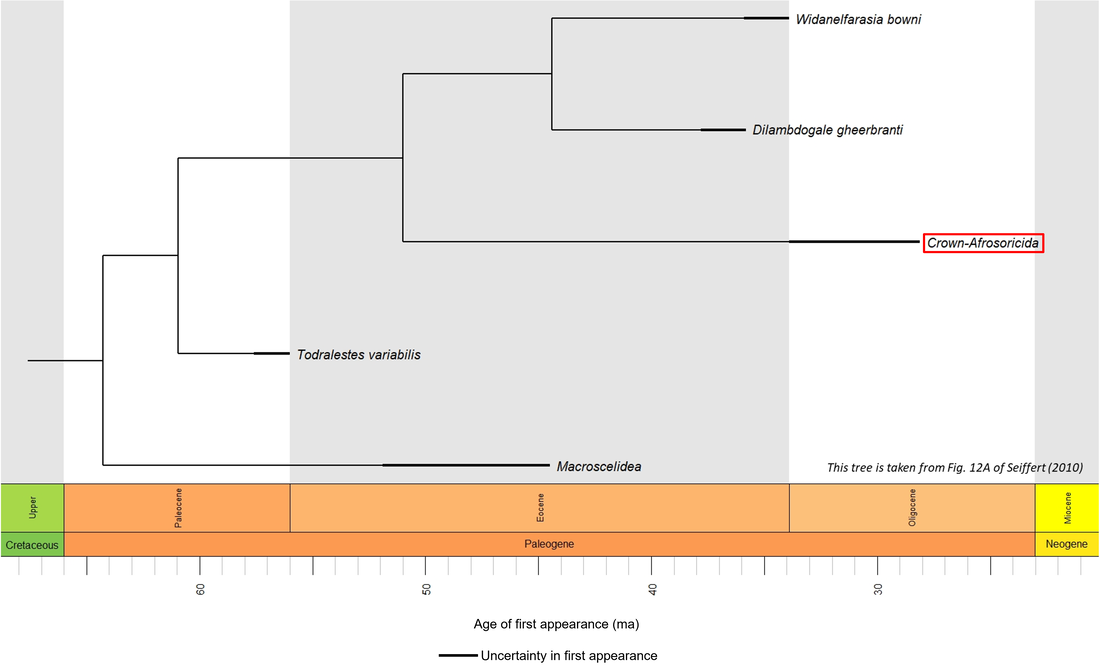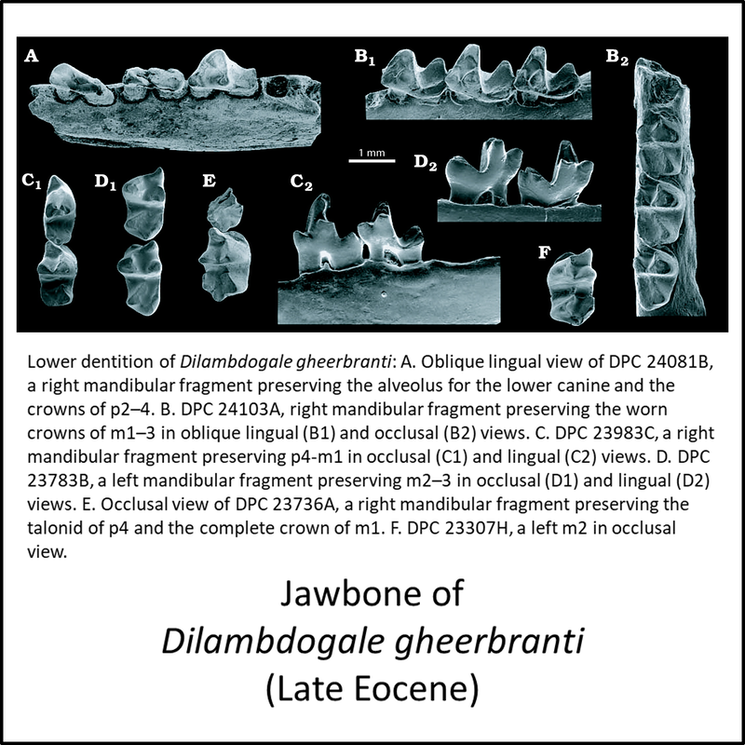The afrosoricids (Order Afrosoricida, Infraclass Eutheria) are small mammals that live in Sub-Saharan Africa and Madagascar. They are represented by two suborders, the Tenrecomorpha and the Chrysochloridea:
The phylogeny of the afrosoricid stem group is illustrated in the following time tree:
- Suborder Tenrecomorpha
- Family Tenrecidae (tenrecs, living mainly in Madagascar)
- Family Potamogalidae (otter shrews, Sub-Saharan Africa)
- Suborder Chrysochloridea (golden moles, Sub-Saharan Africa)
The phylogeny of the afrosoricid stem group is illustrated in the following time tree:
Figure 1. Time tree of the stem-Afrosoricida
The oldest known member of the stem-Afrosoricida is Todralestes variabilis, described from late Paleocene (Late Thanetian) sediments at the Adar Mgorn 1 locality in the Ouarzazate Basin of Morocco (Heritage et al, 2021). No image of this species is available in the public domain, and in fact the only member of the stem group for which any public-domain image exists (apart from single teeth) is Dilambdogale gheerbranti, illustrated below:
Figure 2. Stem-group afrosoricid Dilambdogale gheerbranti
The oldest known crown-group afrosoricid is the stem golden mole Eochrysochloris tribosphenus, described from the Early Oligocene Jebel Qatrani Formation in Quarry E near Fayum, Egypt (Heritage et al, 2021). Again, no public-domain image is available.
As indicated in Figure 1, the afrosoricid stem-to-crown transition took place over a period of at least 22 million years, from Late Paleocene to Early Oligocene time.
As indicated in Figure 1, the afrosoricid stem-to-crown transition took place over a period of at least 22 million years, from Late Paleocene to Early Oligocene time.
References
Heritage, S., Seiffert, E. R., & Borths, M. R. (2021). Recommended fossil calibrators for time-scaled molecular phylogenies of Afrotheria. Afrotherian Conservation 17 https://www. afrotheria. net/newsletter. php.
Seiffert, E. R. (2010). The oldest and youngest records of afrosoricid placentals from the Fayum Depression of northern Egypt. Acta Palaeontologica Polonica, 55(4), 599-616.
Springer, M. S., Murphy, W. J., Eizirik, E., Madsen, O., Scally, M., Douady, C. J., ... & O'Brien, S. J. (2007). A molecular classification for the living orders of placental mammals and the phylogenetic placement of primates. Primate origins: adaptations and evolution, 1-28.
Seiffert, E. R. (2010). The oldest and youngest records of afrosoricid placentals from the Fayum Depression of northern Egypt. Acta Palaeontologica Polonica, 55(4), 599-616.
Springer, M. S., Murphy, W. J., Eizirik, E., Madsen, O., Scally, M., Douady, C. J., ... & O'Brien, S. J. (2007). A molecular classification for the living orders of placental mammals and the phylogenetic placement of primates. Primate origins: adaptations and evolution, 1-28.
Image credits – stem-Afrosoricida
- Header (Lowland streaked tenrec - Hemicentetes semispinosus, Mantadia, Madagascar): Frank Vassen, CC BY 2.0 <https://creativecommons.org/licenses/by/2.0>, via Wikimedia Commons
- Figure 2 (Dilambdogale gheerbranti): Erik R. Seiffert, CC BY 2.5 <https://creativecommons.org/licenses/by/2.5>, via Wikimedia Commons

